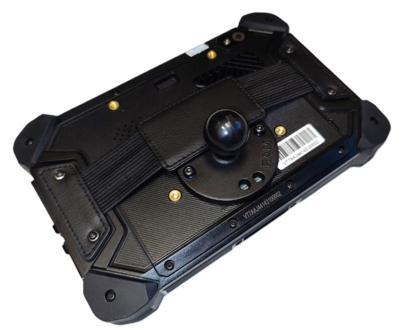Function-First EFB Enjoins iFly Software with Robust, but Average Hardware
Adventure Pilot has released their own hardware to match their iFly EFB software, unveiling a robust Android tablet well-paired to the rigors of cockpit operations.

The tablet goes against the grain of most tablet releases in 2024, sporting a chunky, padded figure and a thickly framed 7-inch, 800-nit screen. The iFly EFB Aviation Tablet meant to perform as either a backup EFB computer or an on-panel device, particularly when paired with Adventure Pilot's dock. The Docking Station allows it to send NMEA data to the autopilot, fuel computer, or compatible EFIS, and connects directly to the Tablet by way of a 24-pin contact point.
It's an aviation tablet first and foremost, which makes for some otherwise unfavorable specifications compared to the average tablet hitting the market today. Where most manufacturers have shaved away their bezels to the point of invisibility, Adventure Pilot retains about an inch of bezel around the screen. That helps give operators more space to hold it, while doing their pre-flight walk around, checking things off the list. Its built-in, chunky bump protection and mounting holes complete the physical package, allowing operators to mount it to 1" RAM balls and shrug off every 5-foot drop off the wing.

The 1,280 x 800-px screen boasts 800 nits of maximum lighting, putting it roughly on par with tablets 3 times its price on the market today, or about 300 nits brighter than the average, well-worn iPad on the flight line today. That should be enough to remain legible even in the sunshine belt of the USA. Graphics and mapping come courtesy of a Qualcomm A53 processor, a long-running but efficient little chip with 4 cores and a 2.0-gHz clock speed. With 5,000 mAh of battery power on tap, Adventure Pilot says the average user will see about 5 hours of use, though field reports point to 7 or so as long as the brightness levels aren't cranked up too high. The Tablet has 4 gb of RAM, and an entry-level 64gb of flash storage. Those specs aren't exactly fire-breathing in 2024, but for those with kiddos in the vicinity, its relatively tame performance could ensure that the EFB isn't pressed into long sessions of 240-hz FPS gaming instead of planning a flight. The Qualcomm unit does just fine in running the full
breadth of the iFly EFB application, with a built-in Adreno TM702 GPU giving it sufficient oomph to render 3d synthetic vision.
Unlike the average tablet today, the iFly unit also offers a handful of input methods, with a headphone jack, SIM card slot, and support for microSD cards up to 512 gb. That helps operators transfer larger bodies of data to and from the plane, should they prefer to leave their Tablet in the cockpit 24/7. Charging can be done via the proprietary docking station or a USB Type-C port on the bottom. For those rare photo or meeting needs when the primary phone is drained, a front-facing 5.0 megapixel and rear 16 mp camera round out the package. The Tablet isn't a tiny little thing, despite the 7-inch screen size: It weighs the better part of 2 pounds (1 lb 12 oz) and cuts an 8.1"x5.3"x1" figure.
"The iFly EFB Aviation Tablet represents a significant advancement in aviation technology. Its robust design and comprehensive features ensure that pilots have the best tools at their fingertips," said Juanita Boyd, VP of Operations at Adventure Pilot. "We are proud to offer a device that enhances safety and efficiency in the cockpit."
 Aero-TV: DeltaHawks Diesel Power Steps Into the Spotlight
Aero-TV: DeltaHawks Diesel Power Steps Into the Spotlight NTSB Prelim: Mooney Aircraft Corp. M20K
NTSB Prelim: Mooney Aircraft Corp. M20K ANN FAQ: Turn On Post Notifications
ANN FAQ: Turn On Post Notifications ANN's Daily Aero-Linx (12.20.25)
ANN's Daily Aero-Linx (12.20.25) Aero-News: Quote of the Day (12.20.25)
Aero-News: Quote of the Day (12.20.25)




